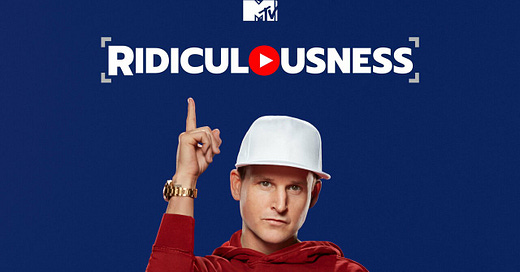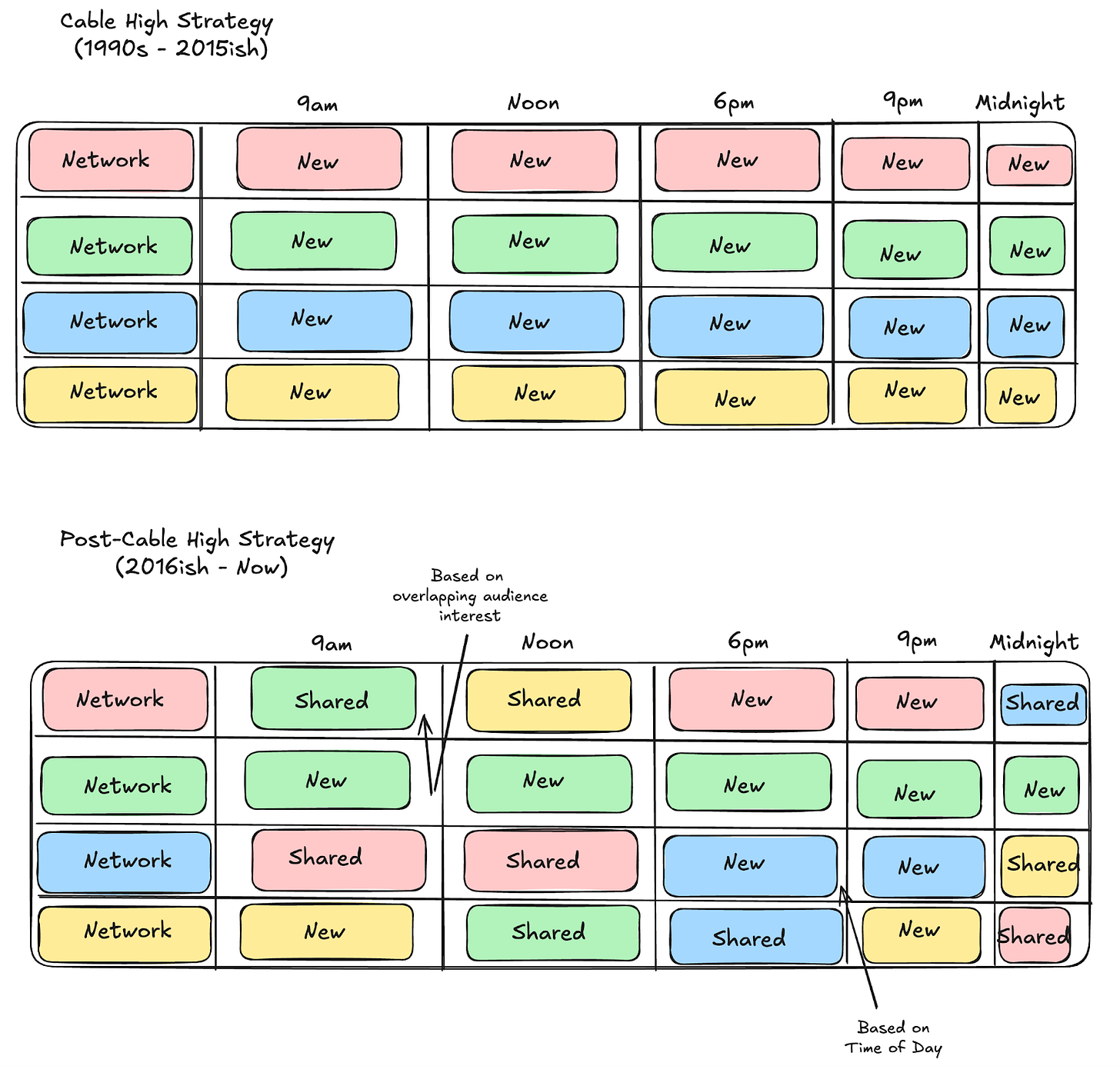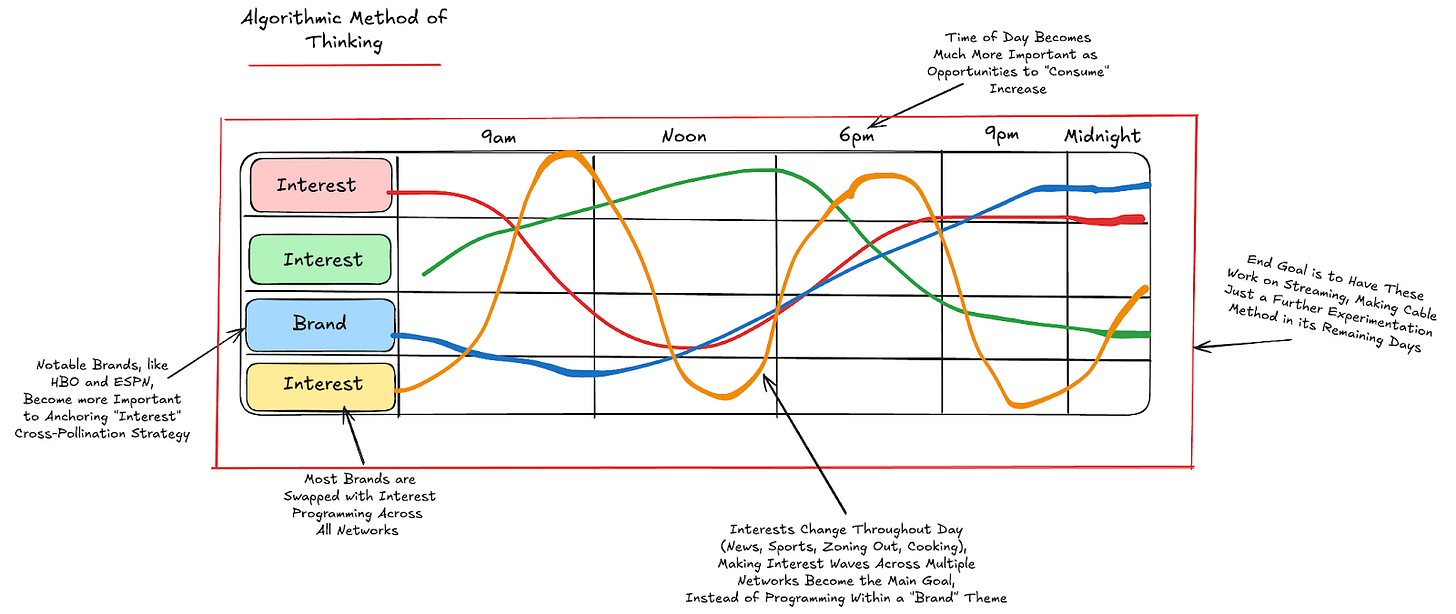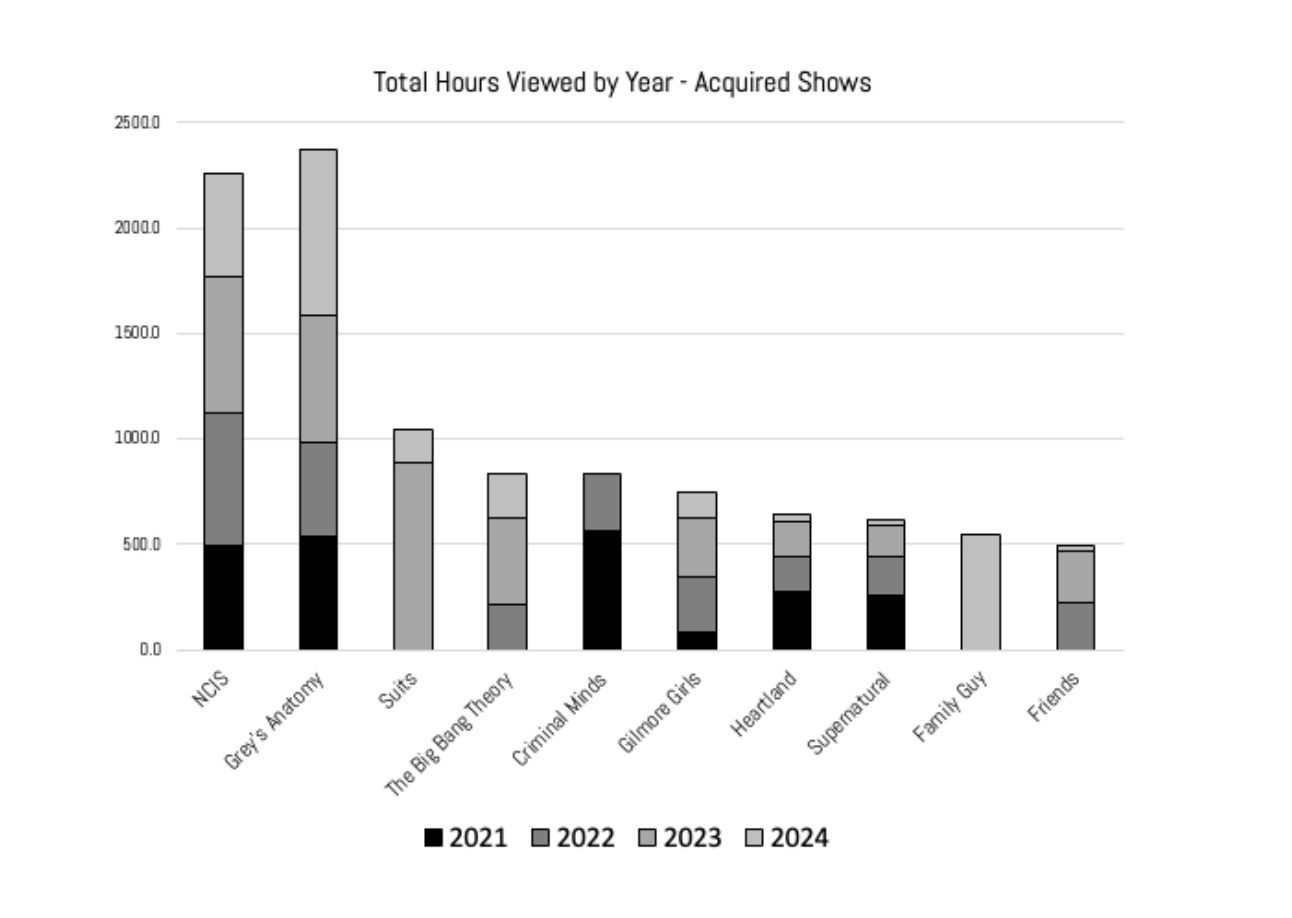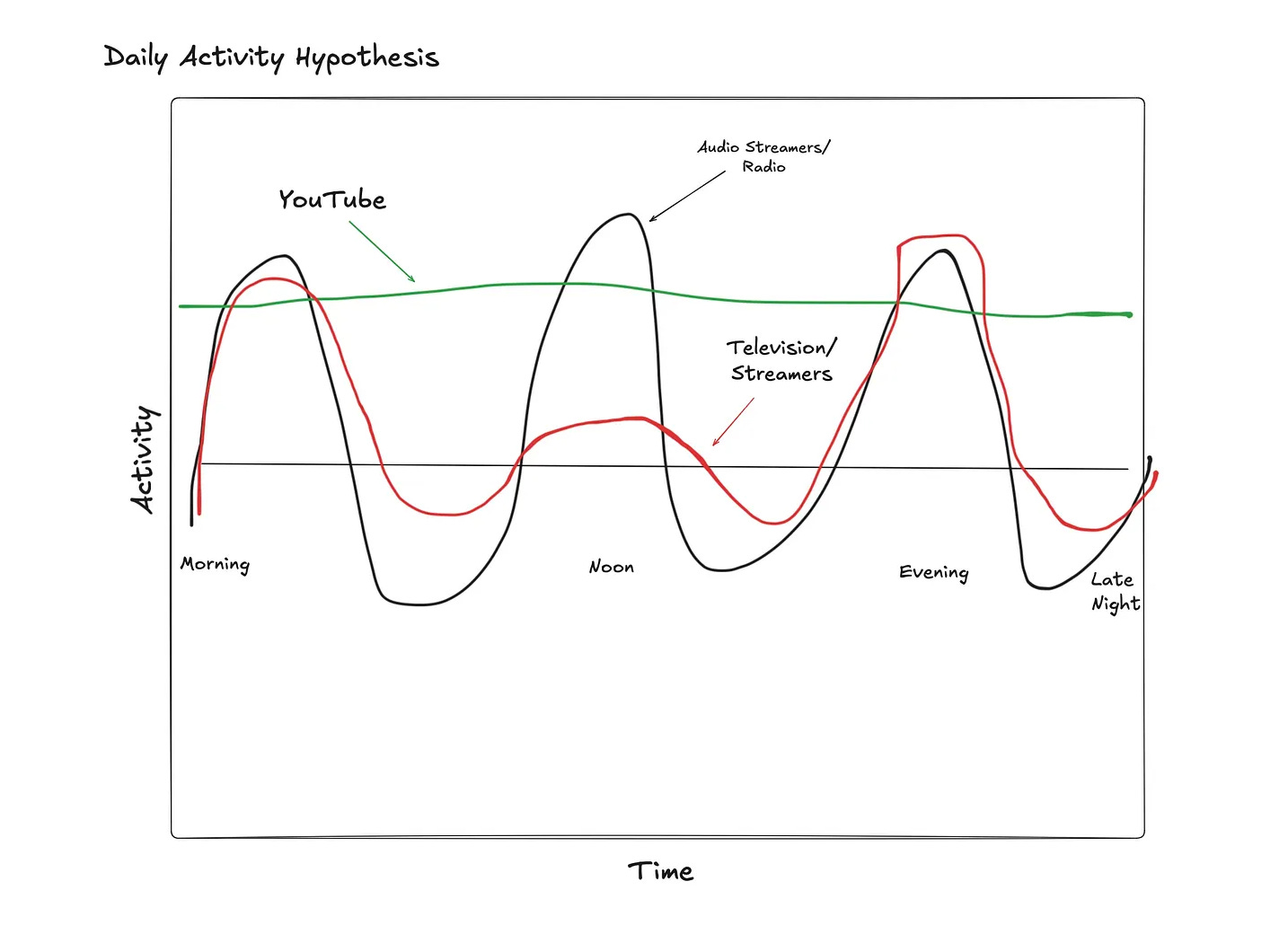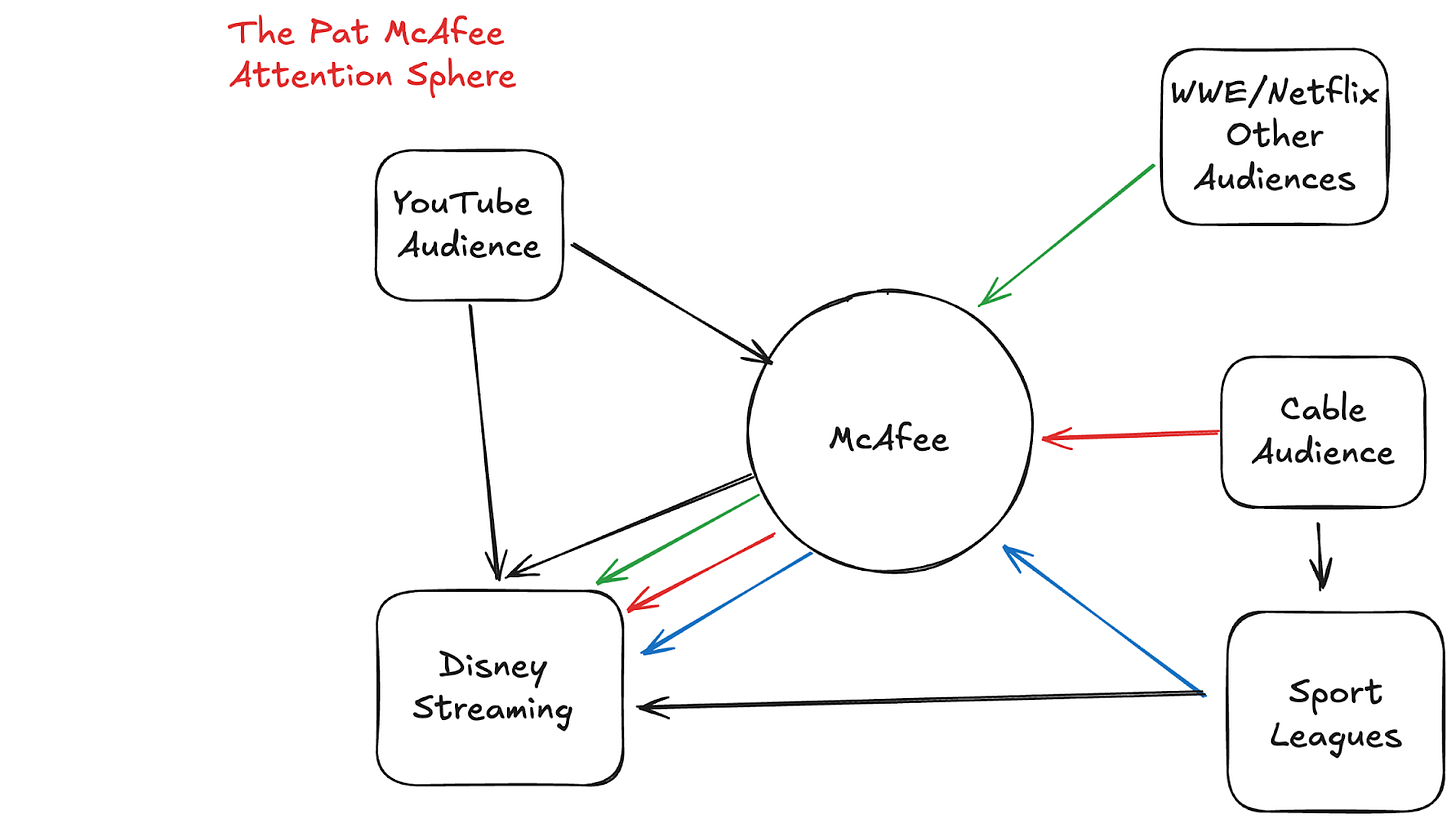A Ridiculousness Lesson I Didn't See Coming
Warner Bros. Discovery CEO David Zaslav's re-approach to cable programming swaps out networks for algorithmic-defined interests
The days of TRL and Jersey Shore are all but over. MTV is now endless reruns of Ridiculousness, shouldered by a new episode of The Challenge or Teen Mom every now and again. MTV is by no means relevant, but it is as efficient as a comatose cable network in 2025 can possibly ever aspire to be. MTV is the anti-Bravo, the anti-ESPN. It’s also the 41st most popular channel in the U.S., according to the US TV Database. What I’ll argue in this essay is that it’s also the blueprint for most cable networks overseen by executives who know these channels don’t have futures but are still struggling to figure out the best way to package all these waning assets to potential buyers, wind down the businesses, and make a better transition to streaming.
Ridiculousness and MTV popped into my head while reading over remarks that Warner Bros. Discovery C.E.O., David Zaslav, made a recent analyst conference. First order of business is cutting down on the overall quantity of content being created for each of the individual networks, Zaslav said. Second, license titles from HBO to other WBD owned-and-operated networks (like TNT and TBS) without additional loaning to third-party networks, according to The Wrap.
“Our food team, our home team, our [Investigation Discovery] team, they’re like studios. So instead of looking at them as cable channels, we start to say, what is the productivity of each of their shows, and how does that work in terms of how good is that content around the world? How good is that content on streaming?” Zaslav said, as reported by The Wrap. “So, we’re not going to be able to fight against this decline, but things like that, using more library, being very measured on what content we produce and how much we produce, which we can change and make variable, and producing more content that works also on our streaming service, I think, will be a real helper to us.”
Zaslav isn’t saying anything revolutionary. Some version of this cable strategy — lifting from networks that produce higher demand television to help bring attention to networks with smaller but similar interest audiences — is a go-to move for many since pay TV’s foundation started eroding. But I do think scaling back to look at each individual network as a tile, each studio as an interest, and building a scale play service off those tactics is more inline with thinking algorithmically.
When money was flowing, it was easy to go all in on new formats, new genres, and new programming as a whole. Drops in subscribers, affiliate revenue, and advertising meant that cable conglomerates had to get more creative. Constant reruns of Friends on TBS, more cheap unscripted programming and, yes, a network dedicated to nothing but Ridiculousness. Pay TV stopped being a place for appointment television, or even background noise (like CNN during the day), leaving executives with a few choices to make:
Sell the network
Hard to do when uncoupling assets, and greater the losses as cable continues to decline
Find repetitive, “sick day” content that works on repeat and can be licensed or rerun at a cheap fee (Friends, Law and Order, Ridiculousness)
Program outside of networks by treating each network as a content supply studio for the wider cable audience
Something I’ve posited when it comes to streaming is that technology doesn’t alter behavior; it allows for a preferred behavior to surface. We can actually see this play out in what works and what doesn’t on streaming. Sports and procedurals being popular with streaming audiences, much like traditional TV audiences, reaffirms that streaming didn’t create new demand for new content.
Hell, even popular YouTubers like MrBeast (game shows), Alex Cooper (talk shows), Dude Perfect (sporting content), and David Dobrik (reality TV) aren’t new. They’re just presented in a different way and served to audiences in a preferred format. Not to be that person, but streaming and user generated content simply thought outside the box of how audiences were able and willing to get the type of content they’ve always sought out.
All of which is what makes Zaslav’s comments about cable much more interesting to me: it’s not just a streaming approach to a linear system, but a YouTube approach. It’s asking how do we need to rethink our approach to human behavior as a whole, regardless of distribution medium, now that we have new data about what audiences want and don’t want; and just as importantly, when they want it and when they don’t want it.
As such, it makes no sense to approach cable for a dwindling audience — who still want access to the same content, but don’t want to jump ship solely to streaming — as usual. But approaching a centralized system with lessons learned from streaming, with content that is ultimately designed for streaming platforms (meaning changes in distribution and access, not in content) could be more efficient while straightening out plans for those dwindling assets. It’d look a little something like this:
That chart looks a lot more like YouTube than cable networks where the content had to fit within the greater theme of a channel, not necessarily what people are actually seeking out. None of these moves are going to save Warner Bros. Discovery’s cable businesses. But that’s not exactly the point. For all the talk about not wanting to disrupt the cable system, behaviors enabled by streaming will ultimately result in the quickened demise of that exact system.
The better way of looking at Zaslav’s plans is looking at one present truth and one future threat. What does the Ridiculousness factor in this long, unfolding story tell us about what will continue to work, and how does the streaming piece of this all — as in, the inevitable cohabitation of these streaming platforms in a largely aggregated environment — tell us about who is in the best position to reap the most rewards?
It’s Not The Content
My friend, who goes by the moniker Entertainment Strategy Guy, has done some of the best work in the space when it comes to tracking detailed ratings, so I’m going to let some of his work do the talking here. (I’d also highly recommend subscribing to his newsletter!) But to set it up, there are four universal truths that have not changed with the advent of streaming, and most of which can be summed up by the Ridiculousness Rule:
Most people still want to watch dramas, procedurals, easy comedies, and true crime
Long-running shows that lend to endless rewatch cycles are still popular
Library shows, or titles that people return to after the big splashy title, still power the vast majority of viewing on speciality networks and/or streaming services
Americans will tell you what they want to watch by watching — again and again and again
Here’s a chart from ESG looking at the most acquired popular shows on streaming in the United States going back to 2021, according to Nielsen data. I like this data set for two reasons. Acquired doesn’t just mean library titles, which newer streamers like Netflix aren’t going to have because of its younger history. Originals make splashes, but acquired series, which are longer and represent the kind of programming that takes up space after someone watches the big splashy original, tell us about larger consumer behaviors. Secondly, the type of acquired fare that does work is exactly what has always worked: procedurals, comedies, and dramas. Family Guy being popular for a streaming audience doubles down on the Ridiculousness cable strategy.
Take the Ridiculousness example a little further. We make fun of the mindlessness of it all; America’s Funniest Home Videos somehow made even dumber. But it works. It’s the seventh most watched show on MTV and within the top 350 shows on television in the United States, according to the US TV Database. Viewership is declining, naturally, but so is viewership across all of cable that isn’t sports. What Ridiculousness does well for its audience, however, is what has worked for streaming.
Gen Z and Millennials spent between 6.3 and 6.4 hours per day with media, according to Statista. More people are spending time with digital talk shows (creators livestreaming on Twitch and YouTube) as more opportunities for media consumption during work hours pop up, including remote work. Time traditionally spent with radio music may switch to Spotify and, similarly, time spent with daytime TV or talk radio may switch to creators who are streaming between 9 and 5.
More than 50% of remote workers in the United States belong to the Gen Z and Millennial cohorts, and more than 80% of these cohorts will work with TV on in the background, according to Mountain Research. I don’t want this to be taken as some kind of “here’s why people should return to office!” diatribe. I don’t care about where people work. I am not a landlord interested in having renters, nor am I a labor economist.
I am interested, however, in how these new labor dynamics combined with new cultures and behaviors more easily enabled by new technologies alter how we approach TV programming. Ridiculousness works because it’s the type of short attention span, repetitive, background television that works during the day.
Ridiculousness for cable viewers does what playlists of MrBeast or Try Guys videos on YouTube for cord cutters and YouTube-first generations. If you’re David Zaslav, and you’re thinking about the type of programming that could work across cable and streaming, that is global, that caters to an audience during a specific part of the day based on specific activities, and you’re trying to find precedent for what’s worked, Ridiculousness (or Law and Order, Modern Family, and Friends) is a pretty strong example.
Paramount Global C.E.O., Chris McCarthy, spoke about this exact thing when asked by Vulture’s Joe Adalian about why Ridiculousness was the show that MTV couldn’t quit.
"'I think you just answered it with the question: ‘In an on-demand world, why do you run with Ridiculousness?’ The same people that ask you those questions, I’d ask them when was the last time they turned on the television and just leaned back and watched for hours on end? If they did, they were going to one of their favorite channels that delivered them one type of show—one of the home shows they create on HGTV or the Housewives on Bravo. The people who are leaning back on and watching linear television, that audience is older. They’re on linear because they don’t want it to change. And what they love more than anything on MTV is Ridiculousness.”
I outlined this a little in last week’s essay on the YouTubeification of everything.
We already have a clear example of how successful digital-first programming on anti-digital networks looks: Pat McAfee and ESPN.
McAfee is a complicated case study, but an important one. Public reports from last year suggest that his ratings are down overall in the noon time slot. A report from January 2024 suggested that McAfee averaged about 312,000 viewers, down 12% from SportsCenter a year prior. Data from the last six months suggests that McAfee hovers between 250,000 and 450,000, according to the US TV Database.
ESPN executives pointed out last January that McAfee’s audience was much larger when taking into account digital and social viewing, something I agreed with at the time and still do today. McAfee isn’t exclusive to ESPN. His program is simulcasted. But McAfee’s other contributions to the network, including hosting College Gameday on Saturdays, as well as his cross network appearances, means more than pure ESPN ratings alone.
Remember: the main goal of pay TV these days seems to be propping up valuable cable networks as much as possible while helping to migrate audiences into streaming consumers. We’ll get more into this in the next section, but think of McAfee as so:
Substance, recognizable brands or personalities, and attention centers will overtake all growth hacks that people come up with for audience subscription businesses. Ridiculousness isn’t a good show, but it’s recognizable and it’s an attention center. McAfee’s daytime talk show isn’t a newly invented format, but McAfee — like Bill Simmons and his Ringerverse or Dave Portnoy and his Barstool audience — is an attention center of recognizable figures that provides some kind of substance for a sizable audience. McAfee ends up being a pathway for cable viewers, sports leagues, and different fandoms that a network like ESPN can build off as it looks to its own streaming future.
Part of why McAfee works well on YouTube also helps to build habits on cable. He’s midday programming. Lunch time tuning in, doing errands background noise. His younger audience are already on YouTube and have his stream open. Similar to Barstool sports. But instilling a new form of appointment noise on cable will carry through for audiences as further migration to streaming happens from every media company in the space.
The algorithmic method of thinking chart doesn’t only take interest and brand into account, but daily routines. You can see this programming on YouTube TV, where morning recommendations (CNBC and CNN for me) are different from midday recommendations (Jeopardy) and nighttime recommendations (a Knicks game). Whatever channel is playing the show doesn’t matter; surfacing it in an easily discoverable way at the right time does.
All of which brings us to the biggest question that Zaslav’s original comment didn’t get at nearly enough: which will be the first company to figure out how to make this all work together to make that final bridge happen once and for all.
YouTube, Amazon, Apple…or Someone Else?
We’ve got to stop pretending like TV’s future is a split between streaming and everything else. As it stands right now, Pay TV is basically home to sports and cable news. Streaming is home to all general entertainment. Eventually, TV of new will look like TV of old, but the key distribution players may change.
Aggregators like YouTube, Amazon, and Apple have competed for some version of this control for some time. Cable distributors like Comcast and Charter have struck deals with content suppliers like Disney and NBCUniversal to carry streaming services as part of the packaged deal. In both instances, however, the problem is that most audiences still aren’t aware of what is available on what platform. That’s by design.
The centralized cable ecosystem of yesteryear was designed around bringing hundreds of channels together and allowing audiences to browse those channels. Networks competed for attention, but distributors weren’t fighting for monthly credit card payments. Cable companies maintained monopolies in different regions and customers went where they literally could. Streaming, however, means constant fighting for attention and credit card payments. Ensuring that audiences aren’t thinking about what’s on another platform is just as important as enduring they see what’s available on the one they’re currently watching.
If you look at the aforementioned algorithmic method of thinking chart above, one of the only ways that works for audiences who subscribe to multiple streaming services (the average is still around 3.6, according to Statista) is to see all content. I have a generalized theory that monthly subs churn at a higher rate than annual subs not solely because of the logistics (obviously the likelihood of someone canceling is much higher if they have a 12x opportunity to do so), and not because annual signups signify a stronger commitment to a product.
Monthly fees (made so much easier to remember with push notifications from credit card companies and tools like Rocket) also create monthly reminders that something is either being used or not. If a service is not being used, and people are reminded once or twice of that $12 fee, then they’ll cancel.
Ensuring that audiences aren’t thinking about what’s on another platform is just as important as enduring they see what’s available on the one they’re currently watching
A highly listed reason that people cancel their streaming services outside of costs is because they weren’t using them enough, and the number one reason for not using a platform is because people don’t know what’s on it or there’s irrelevant programming. Cost is relative to value. We all know this. Customers canceling due to cost is a cancellation due to future perceived value.
Back in 2021, Nielsen found that more than 60% of people couldn’t find something to watch on a streaming service because they couldn’t remember where a title was streaming. This is a testament to the power of brands, of course. But the less brands (ie, networks and studios) that people are aware of as networks turn into content houses for streaming platforms, the more difficult it’ll be for audiences — not fans — to remember where things are in the grand scheme of it all.
We call these “super aggregators.”
Executives are understandably split on the super aggregation theory. Remember that in the cable system, the worst performers were protected by the top performers. ESPN and HBO might command the highest affiliate revenue because of their audience sizes and programming, but being within a unified system also helped third-tier networks since customers paid for giant packages. This is what customers hated, hence the birth of streaming being a nice alternative. We don’t need to rehash history.
But that context is important for understanding why Netflix or even Disney wouldn’t want to “hand over” their content to a super aggregator. Would that help Paramount+ while hurting Netflix’s core advantage right now, which is that no one can seemingly catch up? Maybe! Not to mention that control over advertising inventory and UI is the basis for so many fights, including the initial one between Max and Roku when the service first launched.
So much of television viewing is throwing something on just to have something on. Every night at dinner, my partner will browse through YouTube TV to find an episode of Bob’s Burgers, Survivor, or a game to watch while eating. Some nights are more purposeful in our household. Sundays are reserved for White Lotus. Thursdays are reserved for Traitors. But these are only one hour blocks. The average household watches four to five hours of TV a day. The rest of the time is spent browsing for something to watch, and it’s typically a show people have seen before.
In order to reduce churn by 1%, each streaming service must create an additional seven hours per subscriber per month, according to Antenna and Owl & Co. And they have to do so in a cost effective way. Much easier said than done. Netflix doesn’t have to worry about getting people to open its app or to remember to open its app. But everyone else does. That’s impossible unless people know what’s even available. Zaslav’s approach to cable is a less than subtle signaling that the approach to surfacing programming has to change, even if the approach to programming does not.
Ridiculousness’ lesson isn’t that bad TV works. It’s not that people will watch mindless things just because they need something easy during work, while sick, or at the end of a long day. It’s especially not an example of what we need more of — TikTok has that covered. Ridiculousness is an accessible show within a recognizable brand that leans into being what audiences need for the vast majority of their TV viewing time. We all want to believe people are watching nothing but Severance. They’re watching Severance and a season of Love is Blind.
Better understanding what people watch, when they watch it, why they watch it, and how they’re willing to watch it is so much more beneficial than trying to make everything fit back inside the broken box.

